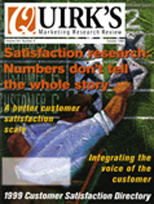Editor's note: Bill MacElroy is president of Socratic Technologies, Inc., a San Francisco-based research firm.
Over time, people in the business of providing online access and services have found that some profound differences exist between the attributes which drive online and offline customer satisfaction. These differences appear to be impelled by six divergent characteristics between the two modes of doing business, each of which we will examine here in some detail.
1. Hyper-evolution of online customer sophistication.
2. Online offers immediacy of comparative offers/increased price sensitivity.
3. Instant access to referent authority/word-of-mouth lowers online cost of information.
4. Online appears to have lower barriers to brand switching.
5. Online one-to-one marketing model yields increased choice options.
6. Offline satisfaction is transaction based; on-line satisfaction is process-based.
Rapid evolution of on-line customer sophistication
Traditional product and brand development has benefited from the fact that off-line consumer tastes and demands can take years to change. Brand positioning, basic messaging, and effective promotional strategies can yield incremental satisfaction ratings increases for decades in the "real world." In the online environment, however, consumers change rapidly as a by-product of experience. Levels of "satisfaction" with an on-line process can change in a matter of months.
We refer to this phenomenon as hyper-evolution of sophistication. Hyper-evolution has a dramatic effect on what will satisfy online users. The accompanying model shows our interpretation of the findings from 15 studies conducted with online users of Internet service providers and e-business sites from 1995 through 1999.
Immediacy of comparative offers/increased price sensitivity
Unlike traditional retail (brick-and-mortar) shopping, online commerce provides hundreds of options instantly (as shown in the price comparison in Figure 2). In-stock positions rather than location or retail brand become critical for the online shopper's consideration. Prices among in-stock suppliers become a second filter for the decision to purchase. Price must also be weighed in consideration of "total cost" including extra costs of shipping, handling, etc. All of these factors give online customers far greater power to decide between vendors. Satisfaction, therefore, becomes highly dependent on availability and delivery performance of those vendors with the best price.
Instant access to referent authority/word of mouth
For offline customers, information about products/manufacturers carries a premium in the real world. Time and effort must be expended to form expectations about goods and services providers. Store personnel are usually not capable of expertise in specific models/lines. Access to word-of-mouth referrals is limited to friends/colleagues. In this environment, brand perceptions play a key -time-saving shortcut to decision-making. Once a satisfactory brand is discovered, there are time and effort barriers to reconsidering one's position. This has the effect of making satisfaction ratings "sticky" for a given brand.
For online customers, however, information about products/manufacturers is available in great detail almost instantaneously. Expert comparisons and evaluations are often available through neutral third-party analysis. Online tools can make specific product configuration recommendations based on the user's specific intended use. Chat boards debate the value of features and refute irrelevant benefit claims. This means that a person's cost of reconsidering his or her level of satisfaction and commitment to a brand is lower.
Lower barriers to brand switching
As the cost of obtaining product information decreases, so do the barriers to brand switching. In a world of information deficit, trust in a brand means a savings of time and effort, but in a world of rich information, brand can become a secondary decision criterion. Some of the biggest real-world brands have been known to produce some of the worst online experiences. Online brands can move faster to create a satisfactory substitute for established brands. It appears that it is easier to establish general credibility online (witness the speed at which E*Trade captured a large share of the securities trading market or Amazon.com's success in rapidly acquiring shares of the book and music distribution channel).
One-to-one marketing increases choice options
Most marketing prognostications say that the system of mass-marketed goods is being rapidly supplanted by online product configuration systems. Individual specifications add tremendous variety to choice. In the online environment, real-time price/feature trade-offs yield optimal customized products configured to the individual user's needs. The volume of choice in features and services yields a much larger range of opportunities for customer satisfaction/dissatisfaction. The hierarchy and pattern of how the individual makes choices becomes as important as stand-alone features in satisfaction measurement.
Driven by perceptions
Offline customer satisfaction appears to be driven more heavily by brand and transaction perceptions. In the real world, fewer elements of information, consideration and choice are scrutinized due to the personal cost associated with gathering information. Satisfaction appears to occur at higher, more generalized levels of perception, most commonly related to brand.
Online satisfaction on the other hand, appears to be more complex and is process-oriented. What is successful for creating online satisfaction differs over short periods of time for the same individual. Tremendous volumes of information and increased choice creates far more points for customer evaluation and resultant levels of satisfaction. Satisfaction can, therefore, occur at many more levels and stages of process. A hierarchy of satisfaction emerges in which some elements of the transaction must be satisfied before others are even considered. Achieving excellence in many elements of the process may be necessary, but they are not sufficient by themselves to create overall satisfaction with the online experience.
